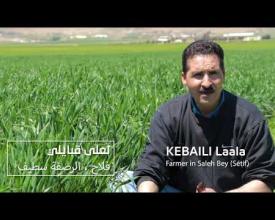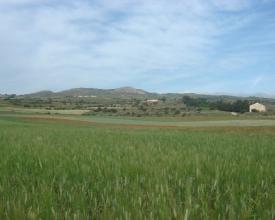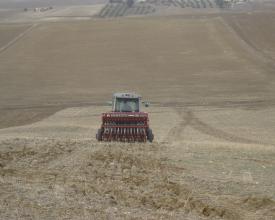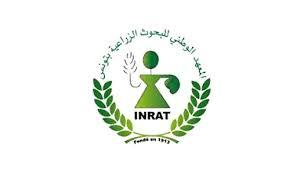
Conservation agriculture draws on locally produced technologies to increase productivity while using fewer resources
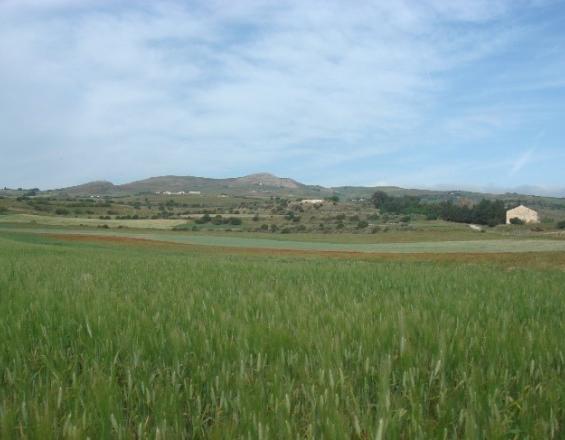
If properly managed, conservation agriculture is generally a "win-win" situation for both farmers and the environment. Conservation agriculture often associated with livestock or local technologies such as zero-tillage seeders, enhances crop productivity, improves resource-use efficiency and soil health. As an alternative to conventional tillage (CT) for rainfed drylands, it avoids soil tillage, saves time and labour and conserves water and nutrients in the soil to make crop production more resilient to climate change.
Context
Challenges addressed
Climate change, erratic environmental conditions and population growth put pressure on agricultural systems. As a result of overexploitation to meet demand, soils are impoverished, which reduces productivity. This is particularly true in low- and middle-income countries in North Africa and Latin America and the Caribbean, where rural people are highly vulnerable to unpredictable and variable rainfall. The increased frequency of droughts and extreme weather events, as well as changing food demands and preferences, further impact crop production and degrade biomass. Conservation agriculture can address these challenges. Used by a majority of farmers in Australia and Brazil, and by many in North America and other middle- and high-income countries, the solution has the potential to improve food security and preserve natural resources in dryland agro-ecosystems in Central and West Asia, the Middle East, and in North and sub-Saharan Africa.
Location
Process
Summary of the process
Conservation agriculture and related training to this practice help minimize the disturbance of the soil, keeping crop residues to maintain soil cover and crop rotation whilst the local-based machinery zero tillage helps compliment the positive impact related to the practice like a complementary solution complementing the core solution. The designed technology uses local inputs and mechanical skills to expand markets for repairs and technical services and create local jobs. As witnessed, farmers switching to conservation farming need chemical help to control weed, which could be economically less profitable for them therefore developing local jobs related to machinery related to conservation can help balance this bottleneck. Training involving farmers are empowering them to develop local markets and machinery that complement conservation agricultural practices.
Building Blocks
Trainings with farmers
By training farmers on conservation agriculture, they learn new smart agronomic practices to diversify the cropping systems, save energy and labour and stabilize yields under dryland conditions.
Enabling factors
- Integrating a gender approach
- Participatory engagement by farmers in the training
- Educating people on conservation agriculture technique
Lesson learned
For the producers and community authorities, there are specific demands for information, training, dialogue and coordination of activities. Innovative agricultural development approaches are needed to inform and demonstrate the benefits of conservation agriculture to farmers. This can be achieved through activities such as: Intensive guidance of farmers to change the centuries-old conventional farming heritage. On-the-job training and creation of ‘conservation agriculture services’ for farmers in areas such as planting and weed control and for support around other practical issues for the adoption of conservation practices.
Local farmer-designed technology
Locally produced, low-cost, zero-tillage seeder uses locally available parts and mechanical skills to expand markets for repairs and technical services and create local jobs. This building block has permitted favouring of subsidies for conservation farm machinery and withdrawing of support for those allocated in conventional practices. One of the complementary innovations of this solution as a practice is a locally produced low-cost, zero-tillage seeder. International Center for Agricultural Research in the Dry Areas worked with national partners and lead farmers to develop, test, and promote the designed or the locally-modified seeders. The designed technology uses local inputs and mechanical skills to expand markets for repairs and technical services and create local jobs.
Enabling factors
- Work with farmers to develop, test, and promote the modified seeders accompanying CA
- Promote local resources
- Trainings to farmers in terms of use and agronomic practices
Lesson learned
In leadership and awareness, leadership to coordinate efforts to reverse land degradation are scattered and not properly recognized. Therefore, there is a need of local initiatives and tools to enhance involvement and sustainability of the solution. The local technology included in this solution, a low-cost, zero-tillage seeder, has permitted an empowerment of local people through the creation of jobs and use of local inputs.
Impacts
- Zero-tillage seeder: Compared to imported machines, the seeders designed by local farmers produce similar yields but feature more sowing adjustability and a higher germination rate.
- Increased yields: In Jordan, where wheat production is often constrained by prolonged drought, farmers in Irbid experienced average wheat yields that were 16 per cent higher than those achieved under conventional practices, generating net returns of US$296 per hectare.
- Government support: After trials demonstrated a 19 per cent increase in wheat yields, Moroccan policymakers are including conservation agriculture in a national effort to reverse falling agricultural productivity and to stabilize yields.
- Local job creation: The farmer-designed technology associated with conservation agriculture uses locally available parts and mechanical skills, creating jobs by expanding the market for repairs and technical services.
- Trainings: Nearly 1,200 women farmers and 600 young farmers were reached in Latin America and the Near East and North Africa region.
- Cost-effective: Conservation agriculture reduces inputs and workloads for farmers.
Beneficiaries
The land users and farmers are the destined beneficiaries of this solution.
Sustainable Development Goals
Story
The land users that have adopted Conservation Agriculture (CA) have indicated that they extremely appreciate the reduction in work also the cost of labour and fuel. Adnen Abdrabbou’s in Tunisia parted with traditional farming systems. He began practising CA instead. He opened up his farm for onsite CA trials to ICARDA and three national agricultural institutes – l’Institut National de Recherche Agronomique de Tunis, l’Institut National des Grandes Cultures, and l’Ecole Supérieure d'Agriculture du Kef. For Abdrabbou, the institutes’ involvement provided confidence, and he became the first Tunisian farmer to pioneer the technique. One of the trials has lasted two decades, making it the most well-known on-farm trial of CA in the country.
“As farmers, we borrow the land for a short time, and we are responsible for taking care of it until we hand it over to our children and their children,” he said.

